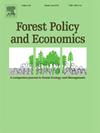Exploring trade-offs in forest carbon storage: A cost-effectiveness study of Nordic forests and harvested wood products
IF 3.8
2区 农林科学
Q1 ECONOMICS
引用次数: 0
Abstract
Forest-based carbon sequestration plays an important role in climate mitigation, yet strategies vary widely in effectiveness and cost. This study compares two optimization goals in the Nordic forest sector, maximizing carbon in harvested wood products (HWP) and in avoided forest harvest plus HWPs. A partial equilibrium forest sector model (NFSM), combined with the method of Modeling to Generate Alternatives (MGA), is used to assess trade-offs between economic outcomes and carbon storage goals. Marginal abatement cost (MAC) curves are indirectly derived from the results. The analysis shows that maximizing avoided harvest and HWP achieves higher CO₂ gains at substantially lower costs (about €15–463/tCO₂) compared to only maximizing HWP (about €44–1200/tCO₂). In addition, the results reveal that carbon-focused strategies reshape industrial and trade dynamics in opposing ways. Bioeconomy-oriented approaches drive production and exports at higher carbon costs, while conservation-focused strategies reduce harvests and raise the risk of market leakage. These findings highlight the need for integrated policies that reduce reliance on product-based carbon storage while strengthening forest-based sequestration and storage.
探索森林碳储存的权衡:北欧森林和采伐木材产品的成本效益研究
以森林为基础的碳固存在减缓气候变化方面发挥着重要作用,但各种战略在有效性和成本方面差别很大。本研究比较了北欧林业部门的两个优化目标,即最大限度地提高采伐木材产品(HWP)的碳排放,以及避免森林采伐加上HWP的碳排放。部分平衡森林部门模型(NFSM)结合建模生成替代方案(MGA)方法,用于评估经济成果和碳储存目标之间的权衡。边际消减成本(MAC)曲线由结果间接导出。分析表明,与仅最大化HWP(约44-1200欧元/tCO₂)相比,最大化避免收获和HWP可以以更低的成本(约15-463欧元/tCO₂)获得更高的CO₂收益。此外,研究结果表明,以碳为重点的战略以相反的方式重塑工业和贸易动态。以生物经济为导向的方法以更高的碳成本推动生产和出口,而以保护为重点的战略减少了收成,并增加了市场泄漏的风险。这些发现强调需要制定综合政策,减少对基于产品的碳储存的依赖,同时加强基于森林的碳封存和储存。
本文章由计算机程序翻译,如有差异,请以英文原文为准。
求助全文
约1分钟内获得全文
求助全文
来源期刊

Forest Policy and Economics
农林科学-林学
CiteScore
9.00
自引率
7.50%
发文量
148
审稿时长
21.9 weeks
期刊介绍:
Forest Policy and Economics is a leading scientific journal that publishes peer-reviewed policy and economics research relating to forests, forested landscapes, forest-related industries, and other forest-relevant land uses. It also welcomes contributions from other social sciences and humanities perspectives that make clear theoretical, conceptual and methodological contributions to the existing state-of-the-art literature on forests and related land use systems. These disciplines include, but are not limited to, sociology, anthropology, human geography, history, jurisprudence, planning, development studies, and psychology research on forests. Forest Policy and Economics is global in scope and publishes multiple article types of high scientific standard. Acceptance for publication is subject to a double-blind peer-review process.
 求助内容:
求助内容: 应助结果提醒方式:
应助结果提醒方式:


